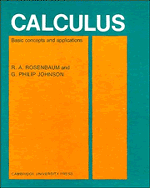Book contents
- Frontmatter
- Contents
- Preface
- How this book is organized, and how it can be used
- Some study hints
- 0 Prerequisites
- 1 Functional relationships
- 2 Rate of change
- 3 Applications of the derivative
- 4 Further differentiation
- 5 Antidifferentiation and integration
- 6 Exponential functions
- 7 Logarithmic functions
- 8 Differential equations
- 9 Further integration
- 10 Trigonometric functions
- Answers to selected problems
- Appendix: Tables
- Index
2 - Rate of change
Published online by Cambridge University Press: 10 April 2010
- Frontmatter
- Contents
- Preface
- How this book is organized, and how it can be used
- Some study hints
- 0 Prerequisites
- 1 Functional relationships
- 2 Rate of change
- 3 Applications of the derivative
- 4 Further differentiation
- 5 Antidifferentiation and integration
- 6 Exponential functions
- 7 Logarithmic functions
- 8 Differential equations
- 9 Further integration
- 10 Trigonometric functions
- Answers to selected problems
- Appendix: Tables
- Index
Summary
We begin now an investigation of the second question raised in Chapter 1: How fast does y vary with t? We shall return to the first question (How does y vary with t?) from time to time as we encounter more kinds of functional relationships.
The development of this chapter follows this sequence of topics:
Average speed as a familiar example of rate of change – of how fast distance traveled varies with time
Average velocity as rate of change of displacement with respect to time
The intuitive idea of instantaneous velocity leading to the concept of limit
Computations of instantaneous velocity
Statements of theorems on limits, to simplify evaluations of limits
Proofs of some results on limits
Geometrical examples: slope of a line, average slope of a curve in an interval, slope of a curve at a point
Tangent to a curve defined in terms of slope
Unifying concept: the derivative as a rate of change, showing how fast one quantity varies with another
A specific formula for the derivative, and several general formulas As you proceed through the chapter, you may find it helpful to refer back to this outline.
Average speed and average velocity
Probably the most familiar example of a rate is found in the concept of average speed.
- Type
- Chapter
- Information
- CalculusBasic Concepts and Applications, pp. 72 - 109Publisher: Cambridge University PressPrint publication year: 1984



